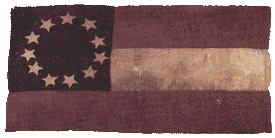

The national significance of the The campaign in question was one of a broad-sweeping set of Confederate campaigns mounted in the fall of 1862 with the aim of securing the border states and the Mississippi river. This sweep, targeted at Maryland, Kentucky, and Mississippi, culminated in the Confederate defeats at Antietam in the east, at Perryville in the west, and at Corinth, Mississippi, dashing all Confederate hopes for those lands. Kentucky was a particularly coveted prize, for holding Kentucky would give the Confederacy a strong front protected by the Ohio and Mississippi rivers, and, as it was hoped, a great increase in manpower, supplies, and industrial capacity. Indeed, Abraham Lincoln is often quoted as having said "To lose Kentucky is to lose the whole game." Confederate General Braxton Bragg had sidestepped Union General Don Carlos Buell and surged into Kentucky via Glasgow, with loose plans to join forces with Kirby Smith, who had already opened the Bluegrass to the Confederates with his victory at Richmond, KY. Although Munfordville, like Richmond, was a small conflict in Civil War terms, the Battle of Munfordville has significance in that it raised Confederate expectations that the Kentucky campaign would result in the defeat of Buell's army, invasion of Indiana and Illinois, and the recovery of Confederate power in the central and eastern portions of Kentucky and Tennessee. General Braxton Bragg's invasion of Kentucky was like a great wave that surged, built to a dramatic crest, and then, having reached this high water mark, broke and receded. The Battle of Perryville was the breaking of that wave. But the crest of that wave, the moment of the Confederacy's greatest potential in the west, was Munfordville. Major Paul F. Hammond reflects upon this potential, writing that "[The successes at Munfordville] were the first brilliant and auspicious fruits of General Bragg's rapid march from Chattanooga. The hopes of the army, and all the friends of the Southern cause, were raised to the highest pitch. The strategy of the campaign was, up to this point, completely successful in all quarters. Buell, hemmed in at Bowling Green, would, it was firmly believed, be compelled to give battle on such advantageous terms that nothing but defeat and destruction awaited him. Benjamin Franklin Cooling concurs: "Bragg stood in a good position to offer Buell a decisive battle for Kentucky. Whether or not it could have occurred at this point remains moot. Adam Rankin Johnson declared later that here was Bragg's fatal mistake, for he felt confident that if the two armies had met at the Green River, as Bragg intended (‘or as he declared he intended'), the Confederates could have crushed the Federal army, and with the aid 'of many thousand assured recruits it could have held the state.'" James Lee McDonough, espousing Stanley Horn's argument, notes that "'[Bragg's] soldiers were inspired by the capture of Wilder's [Munfordville] garrison and might well expect to find Buell's men correspondingly depressed.' Horn then contends, ‘There was every sound reason why Bragg should fight Buell at once, and there is some evidence that he thought of it. But he did not fight. … In a negative way, General Bragg's failure to fight at Munfordville was one of the great crises of the war – perhaps its greatest moral crisis.' One would not overstate Bragg's failure here, says Horn, "by calling it a major disaster of the conflict.' Essentially Horn is following the arguments of Joseph Wheeler, then a colonel commanding Hardee's cavalry brigade, and of Basil Duke, who rode with the famous Rebel raider John Hunt Morgan. Robert S. Henry, a southern historian whose work preceded Horn's by a decade, took a similar view." The Battle of South Mountain, MD, and the Battle of Iuka, MS, led inexorably to the Confederate defeats at Antietam and Corinth (respectively) in much the same way that Munfordville led inexorably to Perryville. But unlike those battles, in which the Confederacy ended in a weakened position, the Confederate success at Munfordville, as noted above, placed Bragg's army in the strongest position it would occupy for the entire campaign, and fueled hopes that influenced future Confederate military strategy. But it was an historic opportunity bafflingly squandered. Indeed, Hammond remarks on Bragg's "incomprehensible failure to attack" and construes that "perhaps the most lamentable consequence of this failure was that it shook, if it did not destroy, the confidence of the army in General Bragg. Confidence which, up to this time, he possessed completely." McDonough agrees, writing that, "Ominously for the future, Bragg came away from Kentucky having lost the confidence of many men and officers, whether deservedly or not." That confidence, thus lost, led to the loss of Kentucky at Perryville, and the fulfillment, for the Confederacy, of Lincoln's prophecy. Munfordville is, then, a unique snapshot of the Confederacy at its greatest potential in the West, and the site of events and decisions that would shape the course of the entire conflict to follow.
|
||